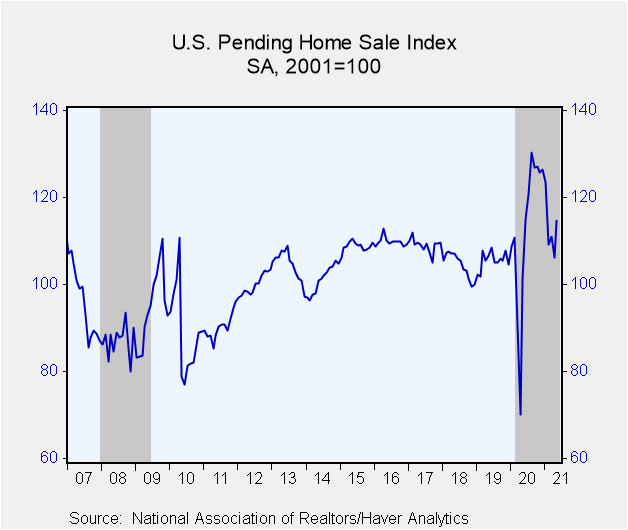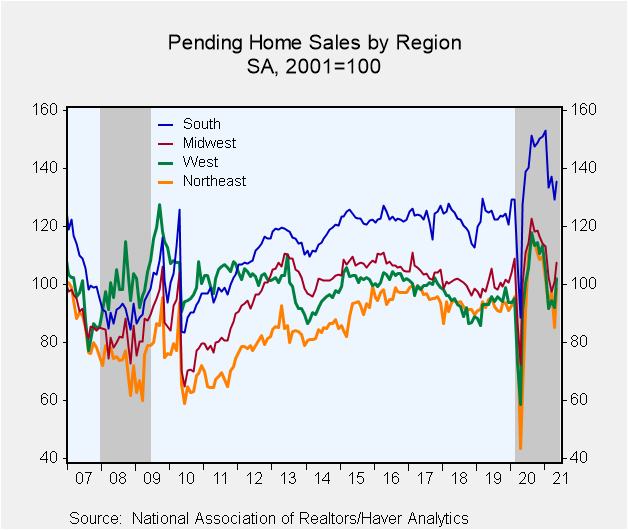 Global| Jun 30 2021
Global| Jun 30 2021U.S. Pending Home Sales Rebound in May
by:Sandy Batten
|in:Economy in Brief
Summary
• Rise in May more than offsets decline in April with gains in each region. • Purchases remain constrained by limited supply and rapidly rising prices. Pending home sales rebounded in May, rising 8.0% m/m (+13.1% y/y) following a 4.4% [...]
• Rise in May more than offsets decline in April with gains in each region.
• Purchases remain constrained by limited supply and rapidly rising prices.
Pending home sales rebounded in May, rising 8.0% m/m (+13.1% y/y) following a 4.4% decline in April. The May level of the index was the highest since January though buyers are still being constrained by rising prices and a near-record low supply of homes for sale.
Sales in the Northeast rose 15.5% m/m (+54.6% y/y) in May, their largest monthly increase since July 2020 and more than reversing their 12.9% m/m decline in April. Sales in the Midwest rose for the second consecutive month following five straight monthly declines. They were up 6.7% m/m (+7.8% y/y) in May on top of a 3.3% m/m rise in April. Sales in the South increased 4.9% m/m (+6.1%) in May, not quite reversing their 5.9% m/m decline in April. Sales in the West jumped 10.9% m/m (+12.5% y/y) in May, their largest monthly gain since August 2020, versus a 2.6% m/m decline in April.
The pending home sales index measures sales at the time the contract for the purchase of an existing home is signed, analogous to the Census Bureau's new home sales data. In contrast, the National Association of Realtors' existing home sales data are recorded when the sale is closed, which is likely a couple of months after the sales contract has been signed. In developing the pending home sales index, the NAR found that the level of monthly sales contract activity leads the level of closed existing home sales by about two months.
The series dates back to 2001 and are available in Haver's PREALTOR database. Weekly mortgage interest rates from the Mortgage Bankers Association can be found in the SURVEYW database.
| Pending Home Sales (SA, % chg) | May | Apr | Mar | May Y/Y % | 2020 | 2019 | 2018 |
|---|---|---|---|---|---|---|---|
| Total | 8.0 | -4.4 | 1.7 | 13.1 | 6.9 | 1.0 | -4.1 |
| Northeast | 15.5 | -12.9 | 6.1 | 54.6 | 2.5 | 0.7 | -5.2 |
| Midwest | 6.7 | 3.3 | -4.6 | 7.8 | 7.7 | -0.3 | -4.6 |
| South | 4.9 | -5.9 | 3.0 | 6.1 | 8.5 | 1.8 | -1.8 |
| West | 10.9 | -2.6 | 2.9 | 12.5 | 5.9 | 1.1 | -7.3 |
Sandy Batten
AuthorMore in Author Profile »Sandy Batten has more than 30 years of experience analyzing industrial economies and financial markets and a wide range of experience across the financial services sector, government, and academia. Before joining Haver Analytics, Sandy was a Vice President and Senior Economist at Citibank; Senior Credit Market Analyst at CDC Investment Management, Managing Director at Bear Stearns, and Executive Director at JPMorgan. In 2008, Sandy was named the most accurate US forecaster by the National Association for Business Economics. He is a member of the New York Forecasters Club, NABE, and the American Economic Association. Prior to his time in the financial services sector, Sandy was a Research Officer at the Federal Reserve Bank of St. Louis, Senior Staff Economist on the President’s Council of Economic Advisors, Deputy Assistant Secretary for Economic Policy at the US Treasury, and Economist at the International Monetary Fund. Sandy has taught economics at St. Louis University, Denison University, and Muskingun College. He has published numerous peer-reviewed articles in a wide range of academic publications. He has a B.A. in economics from the University of Richmond and a M.A. and Ph.D. in economics from The Ohio State University.








